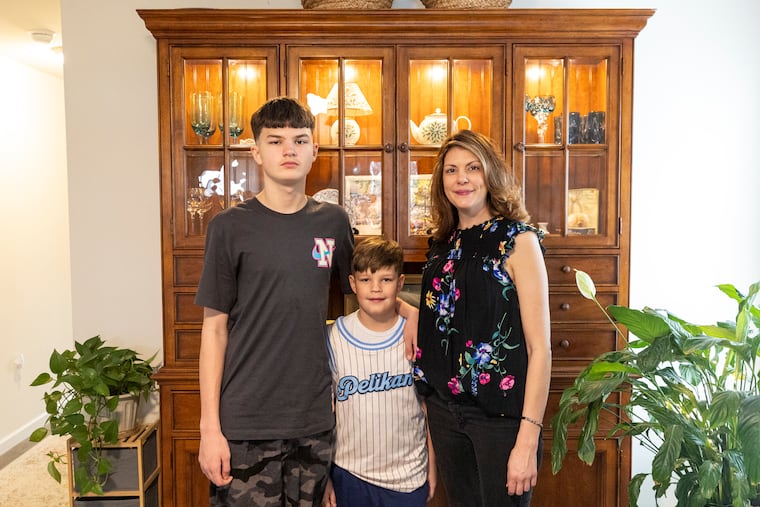Habitat for Humanity is making ‘a dream come true’ for South Jersey families by using modular construction
It takes only about four months from breaking ground to completion for a modular-home build, much shorter than the 12 to 18 months to stick-build a house.

Courtney Pelikan and her sons were outgrowing their two-bedroom apartment in Bordentown when a friend suggested she look into Habitat for Humanity in August 2022. Just one year later, the family moved into their 1,300-square-foot, two-story duplex.
“It’s a cliché, but it’s a dream come true, one that I thought was unattainable,” said Pelikan, an administrative assistant for the state of New Jersey. “Being able to afford to buy my own home is amazing to me and my sons.”
Completing construction on a new home in less than a year may seem impossible, but Pelikan’s house is modular: It was constructed in pieces in an indoor factory and then moved to her Bordentown lot. It takes only about four months from breaking ground to completion for a modular-home build, much shorter than the 12 to 18 months to construct the entire house on-site, which is known as a stick build.
“With modular homes, we’re able to triple production compared to stick homes,” said Lori Leonard, CEO of Habitat for Humanity of South Central New Jersey, based in Maple Shade. “The ability to increase production then increases impact and allows us to serve our community in a much quicker way in this housing crisis.”
For the organization, which provided more than 13 million affordable homes around the world in fiscal 2023, the quicker the better. Pelikan’s home, with three bedrooms and 1½ bathrooms, is part of a five-unit duplex project housing 10 families.
Getting into the modular home business
When Habitat for Humanity started providing modular homes about eight years ago, the start was rocky. After spending a few years perfecting the process, the organization offers a catalog of four standard three-bedroom models: a two-story single family home, Cape Cod, two-story attached duplex, and rancher.
The land is typically donated by townships that are trying to meet their affordable-housing obligations. The building is funded through grants and then sold to qualified families at a cost they can afford — not more than 30% of their monthly income to cover principal, interest, taxes, and insurance.
» READ MORE: More of Philadelphia’s apartments are being built in a factory and put together later like LEGOs
Beyond paying their monthly mortgage, the families must get involved in the process with sweat equity, through helping with the build or providing community service.
“That was one of my favorite parts,” said Pelikan, who racked up more than her required 90 hours through helping on a stick-built construction site, working at the Hamilton ReStore, and helping in the community by providing meals through her church and working with the school PTA.
She was also required to learn about home ownership, the mortgage process, and other topics important for a first time homeowner, often on Zoom sessions set up by Habitat for Humanity.
Modular construction
“Modular homes are built exactly the same way and according to the same building codes as any site-built home,” said Anthony Gentile, vice president of Berlin-based Modular Homes Affordably Priced. “The biggest difference is that they are built inside a huge factory.”
That allows the building materials to stay clean and dry in a temperature-controlled warehouse, and the process won’t be held up for inclement weather. While the house is being built in the factory, the foundation can be constructed on the property.
Portions of the pre-built home are then delivered in boxes by crane and are married together on-site. Once delivered, the home is about 90% complete. Volunteers complete the house, with jobs including painting, installing doors and flooring, and building the front porch, back deck, and shed.
“The houses have to withstand sustained wind and elements on a flatbed truck, so when they’re delivered, they are solid,” Leonard said. The houses are also tested for energy efficiency, which is required.
Pelikan was pleasantly surprised that her energy bills now are less expensive than those from her smaller apartment. She has two-zone heating and air-conditioning, but rarely needs to turn on the systems on the upper floor.
A typical stick-build three-bedroom house costs about $350,000 to build, much of which is covered by donations from individuals, families, corporations, foundations, and the government.
» READ MORE: Philly builder is doing more with less — and says his process could help solve construction’s labor problems
Building a modular home isn’t less expensive than a stick-build, but the time saved on carrying costs, staffing, and overhead, balances it out, Leonard said. If there’s any downside to Habitat’s use of modular homes, it’s that there is less work for volunteers — a mainstay of the organization’s mission.
“Using modular homes is a new hybrid model,” Leonard said. “It’s a way to balance volunteer opportunities with increased production.”
Pelikan and her sons, Grayson, 14, and Odin, 9, love their new home. Coming from an apartment, they can now add their own personal touches, like colorfully painted walls. They especially appreciate their outdoor space, including a yard, covered front porch, back deck, and shed.
“Now, we all have our own space to relax and decompress,” Pelikan said. “One of my dreams was sitting outside on my porch with a cup of coffee during a rainstorm, listening to the rain fall on the roof above me. I get that now.”